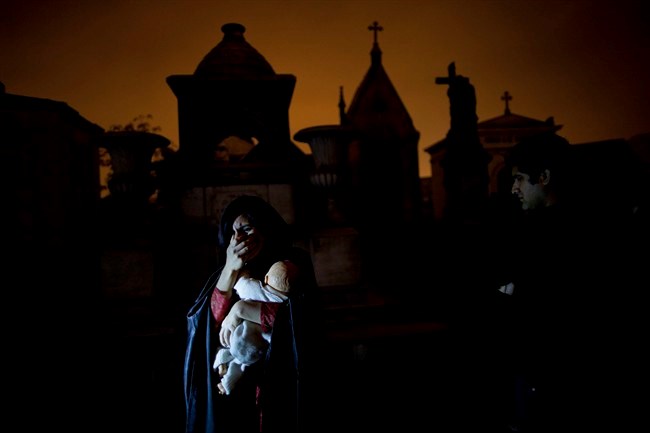LIMA, Peru - When Presbitero Matias Maestro cemetery in Lima received its first body in 1808, the best plots went to the elite, unless the noble had been dishonoured or disgraced.
Thus were the Marquis Torre Tagle and his wife relegated to niches in a wall of crypts. He had attempted to betray independence leader Simon Bolivar and died of scurvy after living on rats for 13 months in a military fort near the Pacific Ocean.
Visitors to the 54-acre cemetery just 20 blocks from Lima's presidential palace, one of Latin America's oldest, are treated to such tales in a three-hour, nighttime guided tour run by its owner, Beneficiencia de Lima, a charity administered by the city.
"There have been 220,000 burials since the 19th century. Are there tormented souls?" asks tour guide Guben Chaparro. "Yes, there are souls, above all at night."
Some visitors shudder. They turn the lights of their cellphones on a parade of tombs, crosses and statues of angels.
"I want to get a fright, listen to stories and walk without light," says Julia Lopez, a 33-year-old store clerk who came with friends for the weekly walk.
As visitors enter, the grim reaper — OK, an actress in a costume — stands cloaked and holding a scythe at the entrance. Photos are snapped.
Guides then tell Peru's history through the tombs of presidents, prelates, poets, potentates and war heroes.
There are also tombs of popular saints the Vatican doesn't recognize. The most popular is Ricardo Espiell, a child who died 119 years ago at age 6 after supposedly performing miracles. Devotees hang neckties around his white marble statue.
"Women wash the child's statue with shampoo and brushes. They bring flowers, gifts, notes. They perfume it and give thanks," says Chaparro.
The cemetery, created by one of the last Spanish viceroys, was established outside the walls of old Lima.
It has a special wall of niches for the obese, another wall for people who have taken their own lives. In one niche, a poet was buried feet first, at his own request.
The press director for the cemetery, Yvette Sierra, says more than 10,000 people have taken the tour in the decade it's been offered. It is only offered in Spanish.
There are no more burials anymore, unless a family owns a mausoleum.
The relative peace of the place can make it eerie, but also contemplative.
"The fear you can feel at the start goes away," said visitor Rafael Vargas, "and you are left thinking, philosophizing about what your life will be after death."
___
IF YOU GO: The tour is offered twice a week, Thursdays at 7 p.m. and Saturdays at 6 p.m. It costs $8 for adults and is only offered in Spanish. Buses for the tours depart from the offices of the Beneficencia de Lima in downtown Lima at Jiron Puno 228, five blocks from the Plaza de Armas, the capital's central square.
The district around the cemetery, Barrios Altos, is among Lima's least safe. It is not recommended to arrive there independently.
Telephone +51-1-427-3798. Ticket sales: Mon-Fri 8:30 a.m.-4:30 p.m. at Jiron Puno 228. On the Net (In Spanish): http://www.sblm.gob.pe/



